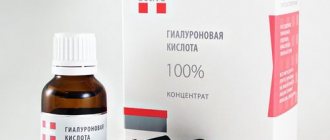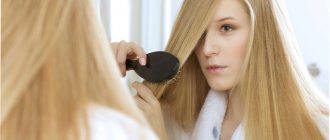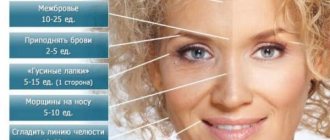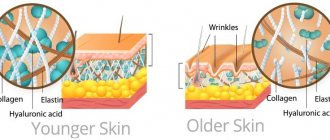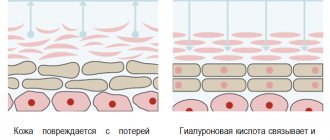Sodium hyaluronate, the miracle salt of hyaluronic acid, has become the hope and mainstay of natural cosmetics in the last decade. The smart Japanese discovered the benefits of hyaluronates, and today anyone on the planet can appreciate the benefits of this natural moisturizer.
You can buy hyaluronic acid, or more precisely, its sodium salt, in the Zulfiya store; there are as many as five varieties on display. How to recognize the one you need? How to properly introduce it into cosmetics? Which hyaluronate is for what? We provide answers to all these questions below.
What are the different types of sodium hyaluronate?
Let's make a brief summary of the description of each type of sodium hyaluronate; there are already five of them in Zulfiya. We list them in descending order of molecular weight, here they are, these beauties.
High molecular weight
(2.5x106) - perfectly cares for the surface of the skin, ideal for gels, because can impart a certain viscosity to an aqueous solution. Smoothes, moisturizes and provides a sleek look. Ideal for water-based primers, moisturizer for mineral makeup, body care.
Medium molecular
(1.3x106) - the size of the molecules is almost half that of high molecular weight, therefore, a 1% aqueous solution will be thinner. Penetrates into the skin much deeper, as the size of the molecules allows. It is introduced into cosmetics without problems, a component of the aqueous phase of emulsions, but is most often used in serums for everything. A universal hyaluronic.
Low molecular weight (0.059x106) - cosmetologists adore this hyaluronate, since a 1% gel (called a gel, but it looks like just water) can revive even the driest and most dehydrated skin overnight. And hair, by the way, too. Used in powerful moisturizers, easily combined with other moisturizing actives, enhancing their effect.
Nano-sized (0.010-0.050x106) - the size of the molecules is smaller than fine, therefore the power of penetration into the deep layers of the skin is unprecedented. One of the bestsellers of the Zulfiya store, a component of many of our ready-made formulas.
Ultra-low molecular weight (8,000 daltons) - occupies a special place among its peers. The most nimble and penetrating sodium hyaluronate, ideal for anti-aging serums, incomparable for the care of colored hair. Produced by fermenting high molecular weight sodium hyaluronate (see above), it has fantastic moisturizing properties.
Any of the five listed hyaluronates can and should be added to cosmetics; the active moisturizes the skin incomparably and can become the core of any formula for any skin type. There is no such thing as too much hydration, and hyaluronic acid salt is beneficial not only to the skin, but also to the hair. Have you tried hyaluronic hair conditioner gel? We lost a lot, let me tell you. The recipe is here, called “ Shine ”.
High molecular weight and low molecular weight hyaluronic acid - action
When purchasing cosmetic products with HA, you should pay attention to the molecularity, which should be indicated in the instructions. This is a characteristic of a laboratory plan, which indicates the length of the chain of a molecule, and, as a result, its weight. The characteristics of the effects of hyaluronic acid depend on this indicator.
High molecular weight hyaluronic acid
(VGK) has dimensions above 1 million Da. It cannot penetrate deep into the skin when applied externally. BHA acts on the surface of the skin, forming a microfilm. Those. its main function is surface hydration. In a number of procedures when using VHA, the result is immediately obvious: the skin is smoothed, i.e. an instant lifting effect occurs.
Low molecular weight hyaluronic acid
(NGK) is to a lesser extent a humectant. It penetrates deep into the skin, regulating the formation of enzymes that maintain the skin barrier and provides UV protection.
Which sodium hyaluronate is used for what?
It is not necessary to have all five types of hyaluronic acid salts on hand. Even with just one hyaluronate, you can create a whole line of skin and hair products.
Recipes with sodium hyaluronate will guide you in the method of introducing it into cosmetics. Traditionally, hyaluronate is introduced into the aqueous phase of emulsions. Cosmetologists like to use several types of hyaluronates in one product - this way a complex effect is achieved, and the skin begins to glow with health.
Do not forget that nail care with hyaluronic acid is one of the most effective methods of restoring the nail plate. After extensions or shellac, manicurists advise moisturizing nails and cuticles with hyaluronic serums. Combine high and ultra-low molecular weight hyaluronate for rapid nail restoration and stimulation of the nail matrix.
Drugs
Sodium hyaluronate preparations can be obtained naturally or artificially. The acid obtained from rooster combs and cattle cartilage could not be completely purified. Animal protein was an allergen. Artificial hyaluronic acid is increasingly used. Cross-linked molecules require much more time to break down in the body, producing a long-term effect.
The production of hyaluronic acid is carried out with the help of non-pathogenic Streptococcus bacteria. The surface of the cultivated bacteria is covered with a polysaccharide capsule. The culture fluid becomes the site of secretion and accumulation of hyaluronic acid. After complex purification, it takes the form of a solution or powder used for the production of medicines.
For facial contouring, preparations produced by microbial synthesis are required. For stabilization, cross-links are created between areas of sodium hyaluronate. The density of crosslinks, as well as the degree of stabilization, affects the viscosity of the gels. For biorevitalization, getting rid of small and medium wrinkles, drugs with a low degree of stabilization are used. Increasing volume with hyaluronic acid requires preparations with a high degree of viscosity.
Long-term clinical results are ensured by their resistance to hydrolytic degradation. The toxicity of cross-linking agents is eliminated by purification of the drug. Its price is determined based on the degree of purification. Hyaluronate is used in cosmetology, as well as for medical purposes - in pediatrics, gerontology, traumatology, ophthalmology.
How to make cosmetics using sodium hyaluronate?
The moisturizing agent disperses well in water, and the higher the molecular weight of the sodium salt, the more viscous its aqueous solution. In practice, only 1% high molecular weight hyaluronate is more or less like a gel; all other 1% hyaluronate solutions resemble water and nothing more. But this water is alive, ladies!
Technologists recommend making hyaluronic solutions an hour before creating emulsions or other cosmetics. Sodium salts need time to distribute evenly; after an hour of “swelling” in water, you need to beat the aqueous solution with a mixer, even if it looks like water.
Non-steroidal anti-inflammatory and painkillers.
Treatment with these drugs is prescribed during an exacerbation of the disease and is aimed at relieving pain and inflammation in the joint or tissues surrounding the joint. For this purpose, non-steroidal anti-inflammatory drugs are prescribed, such as Diclofenac, Ibuprofen, Indomethacin, etc. One should remember the possibility of a strong negative side effect of these drugs on the gastrointestinal tract, liver, and kidneys. It should be noted that the use of these drugs is aimed solely at relieving pain, and not at eliminating the cause of pain.
Chondroprotectors
- These are drugs that improve the structure of cartilage.
Taking these drugs probably helps slow the progression of arthrosis and strengthen cartilage tissue. The most effective of them are chondroitin sulfate and glucosamine
. Long-term use of these drugs can improve the condition of the musculoskeletal system as a whole.
Is it possible to combine different types of sodium hyaluronate?
Need to! The enterprising and smart Japanese based their innovation on this - 3D and even 4D sodium hyaluronate. This sodium megahyaluronate is ingenious, like everything simple - it’s just a cocktail of hyaluronates with different molecular weights.
Skin care based on this mix is distinguished by comprehensive deep hydration; your skin doesn’t need more than that!
We are sure that you appreciated the unprecedented combinatorial power that hyaluronic acid and its five salts provide. Good luck with your hyaluronic sessions and smooth, moisturized skin - you won’t be lost with such assets!
Note:
in molecular weight 2.5x106 the six at the end means the degree. 2.5 times ten to the sixth power.
Product Data
Safety
The safety of the product is confirmed by the following tests:
- Single toxic dose
- Allergy skin test
- Skin irritation
- Eye irritation
- Reaction on contact
- Chronic toxicity
- Reproductive toxicity
Molecular weight
Shiseido offers sodium hyaluronate in different molecular weights, which is available in powder or solution form.
Release form: 1% solution
| The product's name | Molecular weight |
| Bio Sodium Hyaluronate 1% sol. (MP-PE) | 1.37–1.53 x 106 Da |
| Bio Sodium Hyaluronate 1% sol. (PE) | 1.31~1.55 x 106 Da |
Release form: powder
| The product's name | Molecular weight |
| Bio Sodium Hyaluronate HA 9 | 0.8–1.17 x 106 Da |
| Bio Sodium Hyaluronate HA 12 | 1.1–1.6 x 106 Da |
| Bio Sodium Hyaluronate HA 20 | 1.9–2.7 x 106 Da |
Specification of Bio Sodium Hyaluronate HA12
| Property | Specifications | Test Method |
| Appearance | White, fine powder, slight color | — |
| Appearance in solution | Colorless, clear and viscous liquid | 0.5% aq. soln |
| Molecular Weight | 1.2–1.6 x 106Da | JP, Viscosity determination |
| Glucuronic acid | 44–48% | Carbazole-sulfuric acid method |
| pH | 6.0–7.0 | JP, 0.1%, sol. |
| Loss on drying | Max 6% | JP, 105°C, 4 hrs. |
| Other acid mucopolysaccharides | Not detected | Electrophoresis |
| Protein | Max 0.1% | Lowry's method |
| Arsenic | Max 2 ppm | J.P. |
| Heavy Metals | Max 20 ppm | J.P. |
| Microbiological | Max 100 cfu/g | JP Microbial Limit Test |
Specification of Bio Sodium Hyaluronate 1% solution (MP-PE)
| Property | Specifications | Test Method |
| Appearance | Colorless and transparent, viscous liquid, slight odor | — |
| Identification | Positive IR. Absorption detected at wave number 3400, 1610, 1405, 1040 cm-1 | JP, FT-IR |
| Molecular Weight | 1.37–1.53 x106Da | JP, Viscosity determination |
| Viscosity | 13,400–18,400 pPa-S | JP, Viscosity determination method 2 |
| pH | 5.5–7.5 | JP, 0.1%, sol. |
| Arsenic | Max 2 ppm | J.P. |
| Heavy metals | Max 20 ppm | J.P. |
| Assay | 0.9–1.1% | Carbazole-sulfuric acid method |
| Microbiological | Less than 100 cfu/g | JP Microbial Limit Test |
| Specified Microorganisms | Not Detected | JP Microbial Limit Test |
Bio Sodium Hyaluronate produced by Shiseido is used in medical preparations, including in ophthalmic and burn practice, for subcutaneous administration in cosmetic surgery, etc. and is also available in sterile vials for injection.
Powder packaging:
packages of 1 kg.
Packaging for liquid form:
- For Bio Sodium Hyaluronate 1% solution (MP-PE) - 1 kg and 20 kg.
- For Bio Sodium Hyaluronate 1% solution (PE) - 20 kg.
Contraindications and side effects
In case of infectious damage to the organs of vision, such drugs are not used.
The main prohibition against using solutions with hyaluronic acid is an allergy to the components of the pharmaceutical product, so you should not only choose the names of the drugs, but also carefully read the composition. You should not use tear substitutes during acute infectious eye diseases. If the rules of therapy are not followed or if there is a spontaneous allergic reaction, the patient may experience short-term local symptoms from the side effects of the medication:
- redness of the mucous membranes of the eyes;
- itching and burning;
- increased lacrimation;
- sensation of eyelids sticking together.
Some solutions are incompatible with different types of contact lenses. When using hyaluronic drops, negative local reactions may occur in the eye, as well as damage to the lenses themselves. You can find out whether the medication is suitable by consulting your doctor or by carefully reading the attached instructions for use.
Surgery.
Surgical treatment (surgical intervention) is used when traditional conservative treatment is no longer effective
It is very important to determine the stage of the disease when surgical intervention is required. This method of treatment (including endoprosthetics) requires highly qualified personnel, is performed only in a hospital setting and has a high cost of treatment.
After any joint surgery, a long period of rehabilitation and the use of special drug therapy are required. It should be remembered that surgery is irreversible. Therefore, this method of treatment is resorted to only in extremely severe cases of osteoarthritis, when the patient is actually disabled, or in cases of acute inflammatory processes, when urgent surgery is necessary.
The most relevant and important of these treatment methods is drug therapy.
, aimed at eliminating the cause and osteoarthritis itself, and not just its manifestations. Note that surgical intervention is resorted to only in cases of almost complete destruction of the joint or acute inflammatory processes in it.
The most effective today is the combined use of anti-inflammatory drugs, chondroprotectors and intra-articular injections of sodium hyaluronate preparations.
.


